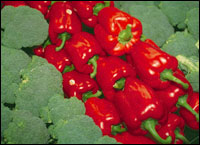Dear Umbra,
Antioxidant foods are “the thing” right now, and I would love to be able to eat as many as I need. However, they are usually the most expensive fruits and vegetables. Would it not make sense for farmers or producers to grow these products in greater volume, so we could all afford them and be able to eat healthier more easily? How difficult would such an adjustment in crops be for farmers in terms of land use, chemicals, etc.?
Oxidated
Dearest Oxidated,
The crux of your question seems to be: Why don’t farmers make my favorite foods less expensive? Forgive me, but I think you’re asking the wrong question. Let me explain.

The producers.
Photo: USDA.
I barely understand the antioxidant concept, but I’m told most green, yellow, and orange fruits and vegetables contain the heralded antioxidant properties. I don’t think you need to worry about the volume of veggies grown. You can be sure that the antioxidant fad is reflected in hectares of broccoli sprouting across California and Mexico, replacing some out-of-fashion veggie (let’s hope it’s the lima bean).
The first thing I would say is that food in the U.S. is cheap. We spend 10 percent of our income on food, less than any other country’s citizens. That doesn’t mean everyone in the U.S. can afford to buy food, of course — there are other factors in play, such as the cost of housing and the minimum wage. Still, consumers are now accustomed to low food prices and, like you, demand them.
The reason I’m answering your question, though, is to disabuse you of the notion that farmers set the price for food. It is a lucky farmer who controls the cost of their product in the United States. About a quarter of each dollar you spend on food goes to the grower. Cheap food is partially a result of government subsidies and price controls that keep consumer costs down, pay farmers to fallow fields or cull herds, and endeavor to control the food market to the benefit of farmers and consumers. Weather also plays a role, and international markets, and the distribution chain is locked around the whole thing.
I know you’ve heard about industry consolidation all over corporate America. It’s happened in the wholesale grocery industry as well, and in combination with vertical integration has spelled disaster for farmer and consumer influence on food markets. Vertical integration means one company is controlling aspects of business that used to be split among separate companies — farm pickup, brokering, packing, and shipping to grocery stores may now be combined. It gives the business even more price control. A consolidated grocery wholesaling behemoth controls a vast portion of the produce market and through that influence is able to control what’s grown, how it’s packaged, and what the farmer gets paid for it. So few options exist that large farmers have nowhere else to go should they want higher prices for their antioxidating oranges.
The only entities likely to control the price of the food you buy are the wholesaler and perhaps the affiliated store itself. You can complain about prices to your grocer, and if enough folks gripe you might see a change. What I would suggest instead is sidestepping the whole system and buying directly from farmers in your area as often as you can. Your food will be fresher, and your money will go directly to a hardworking farmer and straight back into broccoli production. Hence you can reduce your risk of cancer and a farmer’s risk of bankruptcy in one fell swoop.
Free radically,
Umbra


